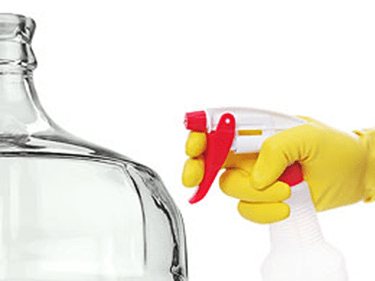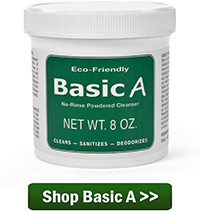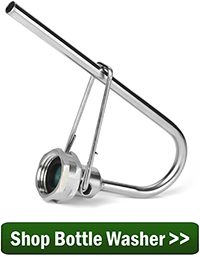 I have a wine instruction book that says to use ammonia for sanitizing wine making equipment. I have some beer instructions that say to use bleach. I understand that is dangerous to use both. But is there a reason for the difference, or can I just use ammonia, or just use bleach.
I have a wine instruction book that says to use ammonia for sanitizing wine making equipment. I have some beer instructions that say to use bleach. I understand that is dangerous to use both. But is there a reason for the difference, or can I just use ammonia, or just use bleach.
Name: Ken L.
State: California
—–
Hello Ken,
I got to be honest with you. I wouldn’t use either one to sanitize wine making equipment.
There are so many excellent cleaners and sanitizers on the market today for the home winemaker to use – cleaners and sanitizers that are both safer and easier to use. It’s come to a point that sanitizing wine making equipment with bleach or ammonia seem almost ridiculous.
I used to use bleach all the time to sanitize my wine making equipment back in the 80’s. There were old wine making books on the subject out there that recommended doing so, but what I found is that bleach is a big hassle that requires contact time and lots and lots of rinsing.
Chlorine likes to cling to surfaces, so one rinsing is not usually enough. I have not ever used ammonia to sanitize bottles or equipment, but I can’t imagine it to be much better.
Today, there are sanitizers that are very quick and easy to use. Some only require you get your equipment wet with it. Then allow it to air-dry. In fact, the air-drying is when all the sanitizing is actually being done with these sanitizers. It’s an oxidative process that occurs as the solution evaporates. No rinsing required. They are much safer because they are oxidative, becoming completely innocuous with a little time.
I would suggest using a product called Basic A No-Rinse Cleanser to sanitize all your fermenters and other wine making equipment. As the name suggest it is a no-rinse cleaner and the one I like the best for sanitizing my equipment.
For sanitizing wine bottles I use sodium metabisulfite instead of the Basic A No-Rinse Cleanser. This is essentially because evaporation can not happen efficiently within the confines of a wine bottle – something that Basic A needs to do to work.
Sodium metabisulfite approaches sterilization a little differently. You mix up the solution as directed on the container and put about two inches in the bottom of each wine bottle and allow them stand up-right for about 20 minutes. Unlike the Basic A, the fumes rising off the solution is what does the sterilizing in this case.
One of the beauties of using sodium metabisulfite is that the wine bottles do not need to be rinsed at all. They just need to be drained. Whatever remains in the bottles as droplets or condensation is fine and will not hurt or affect the wine in any way. We have a great product for draining these wine bottles called a Bottle Tree.
droplets or condensation is fine and will not hurt or affect the wine in any way. We have a great product for draining these wine bottles called a Bottle Tree.
Ken, if you still insist on sanitizing wine making equipment with bleach or ammonia, I would stick with the bleach. Use 1/4 cup to 1 gallon of water. Allow 20 minutes of contact time. Then rinse 3 times. The rinsing is the most important part.
Happy Winemaking,
Ed Kraus
—–
Ed Kraus is a 3rd generation home brewer/winemaker and has been an owner of E. C. Kraus since 1999. He has been helping individuals make better wine and beer for over 25 years.

Ed,
One thing I might mention is that some water supplies, even municipal ones, may not be "clean" enough to rinse with after using chlorine. In this case, a no-rinse sanitizer would be better. It’s definitely quicker, at lest with some of the no-rinse sanitizers. I use iodophor myself and at the recommended 12 ppm concentration, it is a no rinse sanitizer. Tests done by a homebrewing club determined that there was no off-flavors left behind by the iodophor when used as a no-rinse solution. I like the fact that it only takes a couple of minutes of contact time to do its job.
Basic A. If I make up a gallon and use just a part of it, how long will it stay effective stored?
Wayne, Unfortunately, the Basic A will loose it’s strength within hours. This is true for any oxygenating type sanitizer.
I somewhat agree with the bleach assessment, but frequently use it nevertheless. For one thing, it’s really cheap and I always have some at home, which means I won’t be stranded if I run out of another sanitizer at an inconvenient time. I limit it’s use to hard plastics like your Better Bottles and fermenters, and glass. I always follow up with water rinses, after which I wash with potassium metabisulfite solution. In addition to stunning yeast and bacteria, K meta is a reducing agent that can quench any residual sodium hypochlorite (active ingredient in bleach). In a winery setting, where there are a lot of transfer lines etc. that could be contaminated with bleach, it should obviously be avoided-for the home winemaker with simple equipment however, I think it’s fine if good techniques are rigorously followed.
Just curious why you don’t skip the bleach if you are rinsing with a sulphite solution anyway. Seems like you could save yourself a step there.
I’m not going to comment about the effectiveness of ammonia, but if used, there should be no effects on wine quality if the equipment is rinsed and drained following its use.
An ammonia solution (the kind without any detergent in it) residue would simply be utilized by any organisms as a nutrient. If you were to look at the list of ingredients in a package of fermentation nutrients, you’ll probably find that it’s just di-ammonium phosphate. The yeasty-beasties need nitrogen, and the ammonium ion is the perfect source for that.
In other words, ammonia is simply a “pure-nitrogen fertilizer” for the yeast, not unlike using a 21-0-0 fertilizer to boost plant growth. Don’t count on it as your yeast nutrient, however, because there isn’t much left after the rinse, and it doesn’t have any other nutrients with it.
As a professional brewer and home winemaker, I would never subject my equipment to either bleach or ammonia. As Ed said, there are so many alternatives. I have been using (sorry Ed if you don’t sell these) PBW and Star San (foam and no foam) for 25+ years with excellent results. One thing you need to keep in mind with sanitizing is Ph. Acid based sanitizers are IMHO much more suited to the fermenting environment and don’t require rinsing or drying. Using something as strong (yet effective) as bleach can impart off flavors to your finished product even with the finest rinsing and drying techniques. Happy fermenting!
I use a mix of potassium metabisulphite and citric acid for sanitizing all my equipment and bottles. No rinse needed. Works very well! All my wines have never produced a bad bottle.
I have been using OxiClean or simply rince well every jug for over 10 yeas with no problems. I suppose that I have simply been lucky?
I have been using iodophor for my bottles and have had no problems so far. It works well with the bottle rinser that fits on top of the drying rack.
While I cannot comment on the use of ammonia or bleach as sanitizers for the equipment, it is important to know to NEVER mix the two cleansers together due to the potential for dangerous fumes that could cause eye and nose irritation at a minimal and possibly fatal lung damage.